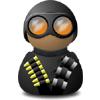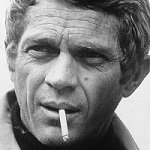"Patience is a virtue”, runs the old adage, but it’s in short supply when it comes to solo games. So I dive in head-first, flipping out the mounted board and picking the quickest campaign options. That turns out to be a Cut-Off mission in the desert warfare of 1942 North Africa. Next up, I have points to spend to pick a force. This being Sherman Leader, I spend most of my allowance on three Shermans. Then, presuming combined arms are going to be useful, I grab an anti-tank gun, a scout car and three platoons of infantry and we’re away.
Except we’re not. The clue is in the name: like other games in the Leader series, Sherman Leader places an emphasis on the officers who lead your forces. I have to pick one for each, shuffling through a huge deck of leader cards of varied skills, specialities and experiences. Bored, I grab the first suitable looking ones I come to. This is my first mistake.
Then I spend most of the rest of my points on trucks and scouts. This is my second mistake.
Campaigns in Sherman Leader consist of a number of weeks. Each week you choose to take on one or more targets from a deck of enemy battalions that get dealt out during setup. Defeating them earns victory points, which you compared to a scale to see how well you did. This being the shortest kind of campaign, it’s only three weeks long. So I figure I better get stuck in.
My first attack is on a Fast Scout Force battalion. It only has four armoured cars, which looks like an easy task. So I send a couple of Shermans against it, saving the rest of my troops to make a second attack this week. I draw an event card, which has a “before” and “after combat section: it’s Poor Training which is bad news if my units get hit. You make up a board from a random deal of hexes and the starting position of the enemy is likewise random. You roll to see what the opposing chits do each turn and mine do nothing on the first turn.
Combat involves rolling two dice against a to-hit value for the shooting unit, either armour piercing against hard targets or high explosive against soft. You modify for range, movement and commander skill and see if you hit. If you do, the defender gets a dice against a defence value modified for cover to see if they survive.
Almost all initial leader cards are rated “slow” for initiative, meaning they act after the enemy. In my previous Leader game, Phantom Leader, this was a moment of terror as you’d wait to see if they survived the incoming missile salvos. Here, to my surprise, it works to my advantage. I’m out of the enemy range at first, but when it’s my turn to act I can move and then shoot. The first armoured car is a smoking wreck.
On turn two they do nothing again, which strikes me as odd behaviour for targets outranged by their opponent. They’re sitting ducks so I smoke another. Turn three they finally advance and fire, but two tiny armoured cars are no match for an equal number of Shermans. I shrug off their attacks and return fire, wiping them off the map. That’s two points in the bag.
Pleased with my success, I go to the after-combat section and immediately lose the entire campaign.

See the after-combat even cards says I have to lose operations points. I didn’t keep any over, and the rules say this is an immediate loss. Despite my impatience, this was an easy thing to miss: the rules are not complex but they’re not the best. Annoyed, I decide to toss out a couple of scouts and trucks instead, pretend I never bought them, and carry on.
Infantry, as you might expect, aren’t much use against tanks in the open expanses of desert warfare. So to make the most of my remaining forces I decide to assault a Dismounted Troops battalion. The random terrain tiles work in my favour, giving me cover to deploy my infantry and artillery into. Infantry, though, have a range of one, making them useless against the enemy units at the top of the map unless they start to advance. Luckily, they do, my “slow” leaders working in my favour once again.
Once the battle is joined, it’s a more tense affair. There’s a lot of enemy infantry and once the units are in range of each other, it’s inevitable that some hits will land. If I hit an enemy counter, it’s destroyed. If one of mine is hit, though, I pull a damage chit. This discrepancy jars - it’s not like German units were inferior to American ones - but it’s necessary to sustain the campaign. I shrug it off as an abstraction and carry on.
Over the five turns allowed for the battle, my position in cover tells as I sustain nothing more than stress while laying waste to the enemy. The only armour on the German side is some half-tracks which my tank quickly dispatches. My artillery, with a hit number of 8, looks useless until I spot that I’ve fortuitously given it a commander with the “spotter” ability which means it can fire at out of sight targets. However, despite my successes, I can’t finish off all the units in a measly five turns. So the enemy battalion goes back on the board at half strength.
It’s a mixed bag, heading into week two. But it’s also been an easy ride, so I decide to up my game and take on some more valuable targets. Enemy battalions move about between friendly and enemy front lines, into positions that can impact your operations points. Since I’m short, I take on the most advanced one, a battalion containing a number of tanks and lighter armour. I send all my tanks into action, reserving my infantry for an easy encounter.
The board deal is not kind, giving me no cover at all to work with and plenty to the enemy. Not that they need it, as the die rolls have them coming out swinging, their Panzer IV and StuG tanks superior to my Shermans. I knock one out but then have one of my tanks disabled, its main gun knocked out making it next to useless. Reduced in firepower, and without cover, it becomes a rout. One of my tanks is destroyed, the others battered beyond repair.
Going over the post-battle steps, it becomes obvious that my units are too damaged to achieve much else. So my campaign ends, much like my first Phantom Leader campaign, in ignominious failure. Such is the price for lack of care and patience. But while both games have similar campaign mechanics, battles feel very different. In the air warfare game, pre-planning was king. You felt like a high-level commander, making a battle plan and sending off your units to enact the details. In Sherman Leader pre-planning is all but impossible. You need to ensure you’ve got armour piercing units to take on armour. But since you don’t see the terrain until the attack starts, that’s as far as it goes. The decisions are replaced with ones on the ground, so they’re of equal challenge. But Sherman Leader feels more like a traditional wargame than previous Leader titles.
That thinking won’t win me a campaign, though. I’m spoiled for choice in that regard. There's a bunch of different length campaigns across a variety of theatres, including fighting the Japanese in the Pacific. First, I want to try a Cut-Off in North Africa again so I reset, taking care this time. I pick up some more armour, pick some new leader cards, poring over their stats and special abilities. There’s an awful lot more to unpack in this single campaign, never mind the others.
And when I’m done I look at the clock and the spread of cards and realise there’s no way I have time to do this, nor space to leave it out. There are cards and chits everywhere. I pull out a counter tray and do my best to try and “save” my setup for next time, but it’s hard work. As the box tucks away, though, I feel it’s been worthwhile. There are plenty of wargames you can spend hours playing solo, but only in Leader games do you never feel that time is spent alone.
 Games
Games How to resolve AdBlock issue?
How to resolve AdBlock issue? 






















